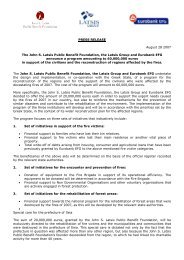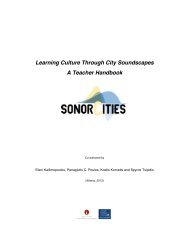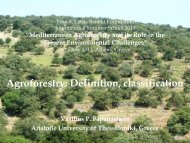Agrosilvopastoral systems
Agrosilvopastoral systems
Agrosilvopastoral systems
- No tags were found...
Create successful ePaper yourself
Turn your PDF publications into a flip-book with our unique Google optimized e-Paper software.
Vegetation degradation andland use changes inagrosilvopastoral <strong>systems</strong>Vasilios P. PapanastasisAristotle University of Thessaloniki, Greece
<strong>Agrosilvopastoral</strong> <strong>systems</strong>‣ complex <strong>systems</strong>‣ crops, trees and pasture / animals‣ silvopastoral and silvoarable‣ combination of components in the same unit of land in a spatial sequence
Vegetation of agrosilvopastoral <strong>systems</strong>‣ rich and variable‣ trees, shrubs, herbaceous species‣ spontaneous, cultivated‣ complex energy and nutrient webs‣ vulnerable to human practices‣ affected by land use changes socio-economic conditions
Historical developmentof agrosilvopastoral <strong>systems</strong>‣ traditional <strong>systems</strong>‣ savanna-like landscapes‣ crop mixtures‣ olive tree in the first millennium BC‣ dehesas in the Middle Ages‣ common land use
Spontaneous evergreen speciesQuercus rotundifoliaQuercus suberQuercus cocciferaPinus halepensis
Spontaneous deciduous speciesMixed <strong>systems</strong>Quercus frainettoQuercus ithaburensisPyrus amygdaliformis
Planted trees (evergreen & deciduous)Mixed <strong>systems</strong>Olea europaeaCeratonia siliquaJuglans regia
Degradation processes‣ Extensification or abandonment‣ Reduction of labor‣ Rural emigration‣ Uplands (mainly)‣ Intensification‣ Mechanization‣ Increase of inputs‣ Lowlands (mainly)
<strong>Agrosilvopastoral</strong> <strong>systems</strong>Wooded grasslandsSilvopastoral <strong>systems</strong>Wooded shrublandsWoodlandsVegetation andland degradationFigure 1. Degradation of agrosilvopastoral <strong>systems</strong> through extensification of management activities
<strong>Agrosilvopastoral</strong> <strong>systems</strong>Tree clearing+Land consolidation+Mechanized agriculture+Industrial cropsOver-pruning of trees+Seeding of pasture species+Improved animal breeds+Increased shocking ratesIntroduction of new species+Employment of dense spacing+Creation of plantation forests+Mechanical exploitationVegetation andland degradationFigure 2. Degradation of agrosilvopastoral <strong>systems</strong> through intensification of management activities
Case study of south PortugalMontadosInfrequent shrub clearingPoor tree healthShrub encroachmentOver-pruning of trees+Too frequent cork collection+Careless mechanical clearing+Over-cropping+Over-stockingVegetation andland degradationFigure 3. Degradation of montados in south Portugal (after Pinto-Carreia and Mascarenhas, 1999)
Dehesas - MontadosOver-grazingShrub encroachmentOver-pruningFrequent cork collection
Case study of central Greece(Portaikos-Pertouli valley)Area: 12.5 Km 2Altitude: 200-2060 m a.s.lPopulation: 4,928 people
Portaikos – Pertouli valleyGeneral viewMixed <strong>systems</strong>Upper part of the valleyLower part of the valley
Table 1. Land cover/use changes between 1945 & 1992 in Portaikos andPertouli valleyCategory Area Change (%)1945 1992Artificial surfaces 84 147 + 75.00Arable lands 1877 1000 - 46.72Grasslands 1589 1084 - 31.78Shrublands 975 872 + 10.56Very open (
PopulationTotal population changes500040001961 1971 1981 19913000200010000Upper zone Lower zone TotalElevation Zone
AnmalsLivestock number changes20000160001961 1971 199112000800040000Upper zone Lower zone TotalElevation zone
Case study of Western Crete(White Mountains)Area: 424 Km 2Altitude: 0-1,800 m a.s.lPopulation: 6,000 people
Table 2. Changes of Mediterranean eco<strong>systems</strong> in the study area of westernCrete between 1945 & 1989Type of ecosystem Area Change (%)1945 1989Phrygana 7,934 6,544 - 17.5Carriques 6,020 4,832 - 19.7Maquis 4,222 3,668 - 13.1Coniferous forests 10,504 12,632 + 20.3Very open ( 70%) 4,648 8,136 + 75.0Total 28,680 27,676 - 3.5
Total population changes
Livestock number changes
End result: wildfires19921995
Case study of central Crete(Psilorites Mountain)Area: 500 Km 2Altitude: 600-2,456 m a.s.lPopulation: 8,000 people
Psilorites mountainCessation of croppingRestriction of treesOver-grazingDegradation
Land cover changes in Psiloritesbetween 1961 & 198940000Ha1961 19893000020000100000ArtificialsurfaceArable lands Forests Shrublands Grasslands Bare rock
1961Evolution ofland cover / use1989between1961 and 1989
Human population
SheepGoats196119711991
Conclusions‣ There is a great variety of agrosilvopastoral <strong>systems</strong> all overthe Mediterranean‣ Eastern Mediterranean has less extensive and organized<strong>systems</strong> compared to dehesas and montados of the westernMediterranean but a great variety of poorly identified andless studied <strong>systems</strong>‣ Vegetation of agrosilvopastoral <strong>systems</strong>, especially trees, arevery vulnerable to land use changes‣ Both extensification and intensification of human activitiesresult in vegetation and land degradation
Recommendations‣ <strong>Agrosilvopastoral</strong> <strong>systems</strong> have a great biological, scenic andhistorical value and should be preserved as cultural landscapes‣ A joint study should be taken across Mediterranean toidentify and study the less widespread and knownagrosilvopastoral <strong>systems</strong> before their extinction‣ <strong>Agrosilvopastoral</strong> <strong>systems</strong> should be included in the agroenvironmentalmeasures so that financial incentives areprovided to their owners for their conservation








